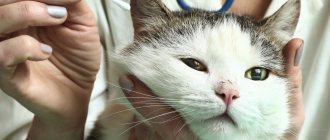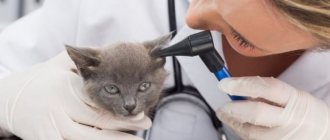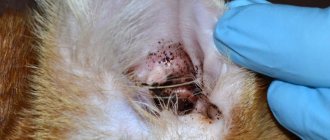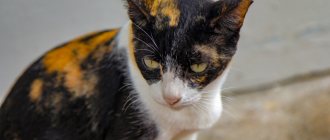Causes of alopecia
The reasons why a cat develops a bald spot behind the ear, or only the tips of the hearing organs are hairless, can be very diverse. It is worth considering the most common among them.
Genetic abnormalities
Hypotrichosis is considered a genetic, inherited disorder. As a rule, it manifests itself at an early age. Kittens remain without fur, and then grow it again.
The pathology is extremely rare and does not pose a threat to the pet’s life. True, it is practically not amenable to therapy. Such cats are not allowed for breeding.
Avitaminosis
The cat's body does not produce vitamin A.
The animal receives it with food. If there is a shortage of this substance, the condition of the coat and skin worsens, and the appearance of baldness is possible.
Obesity
With excess body weight, the sebaceous glands become inflamed and dermatitis develops. Alopecia is also possible.
Due to the fact that the cat cannot provide adequate care for its fur, baldness occurs.
Such a pet needs to be given special food that helps reduce body weight.
Psychological alopecia
Sometimes baldness occurs in animals that are under stress.
When nervous, the cat begins to calm itself down through constant licking. But if you suspect psychogenic alopecia, you should not exclude an allergic reaction, which can also lead to baldness .
Reaction to medications taken
Bald spots in the ear area can appear as a result of taking medications.
If such a reaction occurs, you should contact your veterinarian and replace or completely discontinue the drug.
Helminthiasis
When the body is infected with worms, metabolic processes are disrupted and the immune system is suppressed. A deterioration in the condition of the coat indicates helminthic infestation. In neglected situations, bald spots appear.
Failure of the endocrine system
With endocrine disorders, bald areas also appear. Disturbances in the activity of the thyroid gland, problems with the adrenal glands, sterilization and diabetes can lead to hormonal imbalance.
Infectious alopecia
The appearance of bald areas on the ears is often observed when an infection enters the body. It can affect the respiratory tract, intestines or eyes.
To choose treatment tactics, you must consult a veterinarian.
Lichen
The pathology is caused by fungi and poses a serious danger to people.
The disease manifests itself in the form of bald round areas on which there are remnants of hair (their root part). The skin is covered with scales. The pet suffers from severe itching and scratches the affected areas. Gradually they become larger.
Mechanical factor
This type of baldness is the easiest to eliminate.
Bald spots can appear after a fight with other animals or injury. Special therapy is not required in this case.
Over time, the condition will normalize and new hair will grow.
Disease prevention
Preventive measures aimed at preventing alopecia in cats are as follows:
- regular veterinary examinations;
- timely vaccination of your pet;
- compliance with hygiene rules for cats;
- proper nutrition of animals.
The appearance of bald patches behind the ears, above the eyes and on other parts of the cat’s body is a fairly common phenomenon caused by various etiologies. There are several causes of alopecia (baldness) in pets: mainly endocrine disruptions, food allergies and parasites. Depending on why the cat has receding hairline, the veterinarian will prescribe treatment for the pet.
· Proper nutrition;
· Systematic veterinary examinations;
· Compliance with hygiene rules;
· Systematic vaccination of your pet.
The occurrence of bald patches in the area of the ears, eyes or any other areas is quite common, but it is still necessary to take this problem very seriously. Often the problem lies in endocrine or hormonal imbalance, allergies or the presence of parasites, but sometimes the problem is much more serious, so it is best not to hesitate and contact a veterinarian as soon as possible.
Symptoms You Shouldn't Ignore
If the animal notices the appearance of completely bare areas of the skin or is covered with excessively sparse hair, then it is necessary to consult a doctor. Also of concern are peeling, redness, itching and crusting.
All these symptoms cannot be ignored: there is a high probability that your pet is developing a serious illness.
What to do if your cat's ears are going bald?
In some aspects, a cat's body is similar to a human's. For example, in cats, just like in people, problems with internal organs are reflected in their appearance. Typically, cat shedding is not something out of the ordinary, but if the hair does not recover, then you can start to worry. If a cat's ears become bald, the owner can definitely begin to take decisive measures to save his pet.
First, you need to figure out why your cat's ears are going bald. In fact, this symptom can be triggered by anything, from allergies to stress, and only a veterinarian can determine the real cause.
© shutterstock
However, there are several common factors:
- Allergic reactions;
- Skin infections and parasites;
- Psychogenic influence;
- Hormonal disorders;
- Heredity.
Allergy
Allergic reactions can occur due to toxic substances and various environmental factors; A new food or medication can also provoke an allergy, as a result of which the hair on the cat’s ears falls out, the shells themselves turn red, become covered with a rash, and begin to itch unbearably, which is why the animal scratches its ears too much. Treatment is carried out in only one way - isolating the allergen from the cat's diet or environment and using medications prescribed by the veterinarian.
Skin infections and parasites
- Otodectosis or scabies. Otodectosis occurs due to infection with ear mites, which can cause purulent otitis media. The ears become red and itchy, and the itching can spread down to the neck, causing the cat to try to relieve it by scratching itself excessively. This is what causes baldness.
- Ringworm and other fungal infections. Fungi are very dangerous, so they try to exclude lichen as the cause of baldness in the first place. Emergency veterinary assistance is especially necessary if ear hair loss is accompanied by redness and rash.
- Viruses. Viral infections that cause hair loss in a cat's ears can affect any organ, from respiratory diseases to eye lesions. Only a specialist will help determine what exactly the animal is sick with and choose the right medications; self-medication can only worsen the cat’s condition.
© shutterstock
Stress
Emotional turmoil does not always have a very good effect on animals. A change in the environment surrounding people can lead to the fact that their nervous system cannot stand it: the cat may refuse to eat, begin to hide, the owners may notice that its hair is falling out (on the ears and not only). If symptoms have recently appeared, you can try to calm your pet yourself. For long-term effects of stress, it is better to consult a specialist.
Hormonal disorders in the cat's body
Very often, ears go bald when hormonal problems are diagnosed. One of the manifestations of such disorders is hyperthyroidism - in 30% of cases, in addition to other symptoms, the ears become bald. A cat may also have hypothyroidism. Both of these diseases are associated with dysfunction of the thyroid gland. With diabetes, the hair throughout the body begins to dull and fall out.
Unfortunately, only a veterinarian can accurately determine the disease, so if symptoms appear, it is better to seek help.
Heredity.
Sometimes receding hairlines on and behind the ears appear as a result of a gene mutation and are passed on from generation to generation. Perhaps the ancestors of the balding cat had individuals with similar bald spots? In this case, you don’t have to worry about the health of your pet’s ears.
© shutterstock
Useful materials:
- Cutaneous horn General description of the disease Cutaneous horn on the forehead or face (ICD 10 code - L57.0) -...
- Cloudy eye in a cat Common causes of cloudy eyes in a cat The most common causes of cloudy eyes are glaucoma, cataracts or keratitis.…
- Itching and odorless discharge Main causesBefore considering the factors that provoke the appearance of discharge that has a sour odor, it is necessary to immediately note...
- Normal temperature in animals Normal temperature in different types of animals Veterinary services Day hospital for animals Veterinary certificates Vaccination…
How to help a cat
Treatment is selected taking into account the general health of the pet and the factors that provoked baldness.
Medications
After determining the cause of baldness, certain groups of drugs are prescribed:
Allergy. Immunostimulating and antihistamines are prescribed.- Parasites. They resort to the use of antiparasitic drugs.
- Infection. Antibiotics are used, for example Amoxicillin.
- Stress. Drugs that have a sedative effect are used.
- Lichen. Antifungal agents are prescribed. The most commonly used are Ketoconazole or Griseofulvin. In addition, agents are used that stimulate metabolic processes and support immunity.
- Endocrine system disorders. Hormonal medications are indicated.
Traditional medicine
Resorting to the use of folk remedies is strongly discouraged. Often, when using them, there is a deterioration in the animal’s condition.
In addition to drug therapy, it is worth excluding potential allergens from your pet’s menu and providing him with peace. Self-medication is strictly prohibited .
How to treat alopecia in cats
The nature of the treatment depends on the cause that provoked the appearance of local bald patches. If the disease is allergic, it is necessary to isolate the animal from exposure to allergens. “The veterinarian should prescribe immunostimulants and antiallergic drugs to the cat.” In addition, the animal must adhere to a special hypoallergenic diet.
If alopecia is caused by parasites, the animal is recommended to use special sprays, gels, and ointments that have antiparasitic properties. In addition, the cat should additionally take vitamin complexes to stimulate immune function.
Abscess and pyoderma, which also provoke alopecia, are treated by treating the skin with systemic and external antibiotics, as well as antiseptics.
Taking hormonal medications is indicated for endocrine alopecia, but if the disease is of a psychogenic nature, the cat is prescribed sedatives.
How to accurately determine the cause
In order to make an accurate diagnosis, the doctor examines the animal, listens to the owner’s complaints, and takes an anamnesis.
Additional diagnostic procedures may be prescribed:
study of hair follicles;- blood analysis;
- determination of hormone levels;
- skin scraping;
- X-ray;
- Ultrasound.
Tick-borne dermatitis as a cause of wounds
The appearance of crusts and wounds on the tips of the ears in cats may be due to the activity of subcutaneous mites. There are several types of parasites that are always present in the body of animals. Active reproduction of ticks occurs against the background of decreased immunity, for example, after illness or as a result of a lack of vitamins.
Small kittens and older animals experience tick-borne skin lesions. The waste products of the tick poison the body, therefore, in addition to the crusts, there is always a general deterioration in the animal’s well-being.
Infection of the skin by mites is accompanied by itching and irritation of the epidermis, as a result the cat scratches its ears, which causes the appearance of crusts. The disease may be accompanied by the formation of weeping erosions; heterogeneous areas - plaques and tubercles - can be felt under the skin. Often, against the background of tick-borne skin lesions, wounds become infected with bacteria or fungi, which aggravates the course of the disease.
Prevention measures
To avoid hair problems, you need to follow these recommendations:
- choose high-quality food that matches the condition and age of the cat;
Give your pet antihelminthics at intervals of three months;- regularly treat the animal for fleas;
- eliminate all factors that can lead to the development of allergies;
- vaccinate in a timely manner;
- provide your pet with complete care.
The appearance of bald patches: what to do
A cat owner who notices the appearance of bald spots should not self-medicate. The pet should be taken to a veterinarian to determine the cause of the illness. The doctor will conduct an examination and prescribe adequate treatment.
Prevention measures:
- feeding with quality feed,
- regular hygiene procedures,
- timely vaccination of the animal,
- taking vitamin complexes,
- regular checkups with a veterinarian.
Be sure to read:
Sores on a cat’s neck that itch and hair fall out: normal or pathological, reasons, what to do











